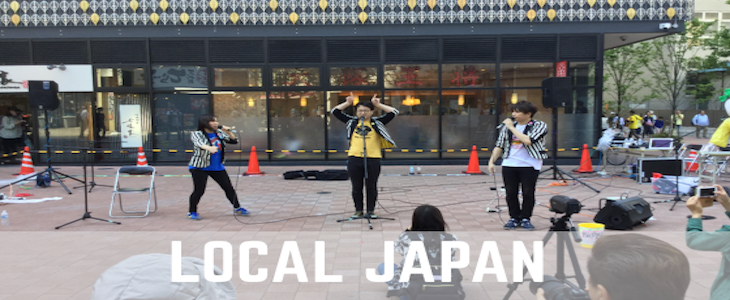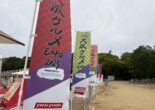
Local Japan: Kashiwa City – Nature and People Coming Together
I’ve lived in a few places in Japan. The first place was a charming but remote castle town in Shikoku, where I lived for a year while teaching in local schools. I then returned to Canada, where I picked up my career, and spent time catching up with family and friends. But I longed to come back to pursue that martial path I told you about, and on the way, came to live in Kashiwa City.
However, I didn’t start there. In the spring of 2003, I landed a job that would bring me to the greater Tokyo area. For the first year, I lived in Chiba City, commuting to a workplace in central Tokyo, but preferred to be closer to my friends and dojo colleagues. Kashiwa City, on the Joban Line looked like the best bet. I had been transiting through the station for months on my way to martial arts dojos and visiting with friends.
I also realized, even if I changed jobs, I would have easy access to train lines into Tokyo, Ibaraki and Saitama. The Joban (local and express), and Tobu Lines going north to Saitama and south to Funabashi stop at Kashiwa Station. Further up the Tobu Line, just a few stops north of Kashiwa Station, the Tobu Line intersects with the Tsukuba Express Line. The station, Nagareyama Ootakanomori, is so long that, even when a conductor rattles it off quickly, you know the destination because it takes so long to say.
The first real estate agent I talked to in Kashiwa was very kind, and patient with my slow and careful talk, as I was only just beginning to get a grasp of the Japanese language. Between little diagrams, painstakingly copied kanji from dictionaries, and a bit of “Nihonglish”, I managed to convey my wish list of features, and the price range I was aiming for. The first place he showed me was a 1K – a six mat room with kitchen and bath. It also had a sleeping loft. This apartment in a two-story building just east of Kashiwa Station suited me fine.

The neighbourhood was a good mix of wooden walk up apartments, concrete “mansion” (concrete condominium) buildings, and detached houses with a lot of greenery behind and between the buildings. By the time I settled in it was early autumn, and when I opened the doors and windows to air out my room, the breeze brought in the scent of kinmokusei, fragrant olive, from the surrounding gardens. I realized I missed keeping flowers and vegetable patches like I used to in my hometown. That is when I noticed that the slope behind the building. The neglected space, as wide as the building, had a few scraggly azaleas and hydrangeas. The side yard, too, had some potted plants. I wondered about discretely clearing a patch and placing some herb plants there. So in the evenings, I picked away at the stones and weeds, discovered landscaping stones and bricks that made a good path, and put in a few rosemary, oregano, and lavender plants.
I got bold after the success of the herbs, so I grew eggplant, kabotcha, tomato and cucumber. It was when the kabotcha became a very obvious many-armed monster, and produced a lot of pumpkins, that the landlord noticed my mini farm. He asked if I was responsible. I admitted it and apologized immediately, and to my surprise he praised me and handed me some money to keep it up. I shared the produce with the landlord and the elderly couple across the street, and in return they gave me advice and seedlings. The experience gave me something to talk about with the neighbors, and I learned a lot about gardening in a very different climate and environment compared to my hometown in Canada. And I found it therapeutic, as a way to relieve the stress of some intense job situations, taking aggression out on weeds, and receiving a lot of pleasure from harvesting my own produce.
Even if I hadn’t had a patch of ground to cultivate, I still had many parks and green spaces to find refreshment. The largest of these, Teganuma Marsh, despite being treated roughly over the last 70 years or so, has survived as a resource for local people. Local elders will tell you that, in the 1950s, fishers could see the bottom of this spring-fed lake, the fish haul was plentiful, and it was a popular swimming spot in the summer. Gradually, runoff from agriculture and household wastewater damaged the lake’s health, and it was designated as one of Japan’s most polluted bodies of water. Disregard for the natural resource led to a proposal to build an amusement park in the 1960s, even a Disney park, but fortunately the plan was opposed. As awareness of the importance of the marsh for the health of the environment and community grew, water quality control projects and preservation began. The measures have gradually improved the lake conditions, and today, the lake supports native animals, and migrating birds. Between 2004 and 2005, the city built a cycling and walking path along the Kashiwa side of the marsh, from Kashiwa Furusato Park to Teganuma Fishing Center in the east. Combined with the parks and paved paths on the Abiko City side, there are about 18 kilometers to explore. The paths give access to the produce stand at the “michi no eki” roadside station, the hot spring spa, the floating lotus garden, and woods in which to get lost.

Sometimes, when I was feeling energetic, or stressed out, I got on my bike and wandered beyond the marsh. On one trip towards the Tone River, I noticed a Tudor style mansion next to a massive thatched roof building, all hidden behind a high fence. This property, Yoshida Residence, once the home of village headmen in the district, was soon opened as a city heritage site. Two friendly retired city employees interpreted the architecture and history in both English and Japanese for me. I learned from them that the house is as grand as any of the other surviving heritage buildings in Tokyo because the owners spared no expense to bring from the capital the best carpenters and gardeners to plan and build the estate. Over the years, I have brought friends from abroad to meet the guides and tour the estate.
The guides recommended other places of interest in the area, and a great resource, the Kashiwa Information Center. This storefront at the south exit of Kashiwa Station is one of the results of Kashiwa being classed by the national government as a “core city”, a center for prefectural level functions including tourism. In the last 10 years, Kashiwa City has developed guides for visitors and residents. The back streets around the station are crammed with great lunchtime places, international cuisine, and well-known ramen shops, all indicated on an English guide map. Besides dining, there are guides to the various vintage and new clothing shops, and other specialty shops within a 10-minute walk of the station.
The center provides information about the many seasonal, arts, and cultural events in the city. The biggest party in the city is Kashiwa Matsuri at the end of July. My apartment, so near the core of the city and the parades, was a place to cool off, and invite friends to take a break from the crowds. Nearly every year during my time in Kashiwa, I danced in the Kashiwa Odori, the local version of the ubiquitous festival dance, either in jeans and t-shirt or yukata. The highlights of the festival are the wild omikoshi parades and the performances by the award-winning municipal high school marching band. Another big event in summer is the Teganuna fireworks in early August, when over 13,000 fireworks, including character starmines, are launched.

In the autumn, I enjoyed the arts and food events. The city is one of the sites for Joban Art Line, a four-week community project to showcase performers and artists, and provide hands-on art experiences for people of all ages. One of the fun things residents got to do was paint floral designs on the station front street, which lingered for months after.. In September, city restaurants and cafés participate in “Yuruberulto”, Loosen Your Belt, a tasting cruise. Diners buy a set of tickets that are exchanged for one dish and a drink at about 100 participating shops. Sometimes, long lines form in front of the most popular places, but I found that I could trade tips with other diners while I waited.
Throughout the year, Kashiwa Shrine hosts a craft and produce market where producers and community members can meet and make a personal connection. Over many years, I made friends with a potter there. Every time I serve tea in her teacups, I remember our conversations at the market.
Kashiwa also attracts a lot of musicians and performers, and nearly every day, there is some performance either on the street, or in the cafés, bars, and band spaces near the station. On Friday and Sunday evenings, bands and break-dancers use the east deck of the station as a practice space. Occasionally, international artists play ethnic or classical music. At little bars in the city, I made friends with blues and jazz artists, and sing back up for fun.
Although I have moved on to Noda City, about 30 minutes north on the Tobu Urban Park Line, I visit Kashiwa City now and again. Whenever I visit, I catch up with residents, both local and foreign, at the usual haunts. Sometimes I think back on the first few years I was just getting adjusted to living in the city, and learning the language. I had some struggles, but mostly I remember the kindness of people. The sushi chefs who taught me Japanese puns. A stranger who handed me his umbrella when he saw me soaked by a sudden downpour. Elderly farm ladies giving me directions in the dialect that was once common in the district. Despite being just another part of the vast Tokyo conurbation, Kashiwa still has its own particular charms and local pride.




